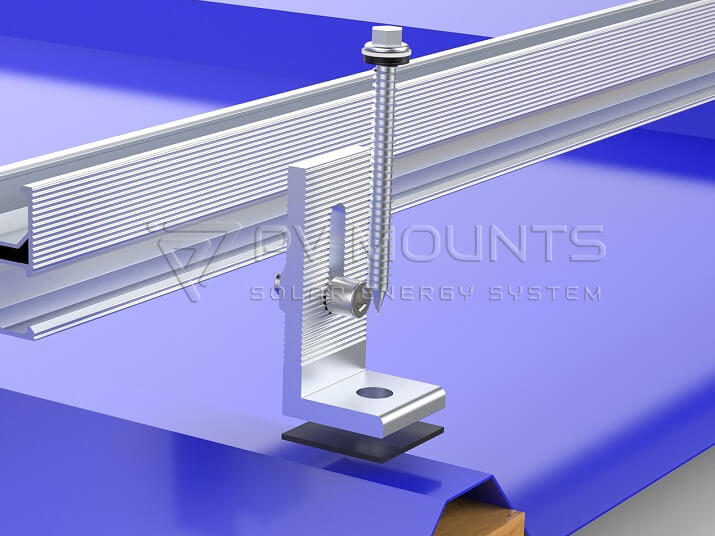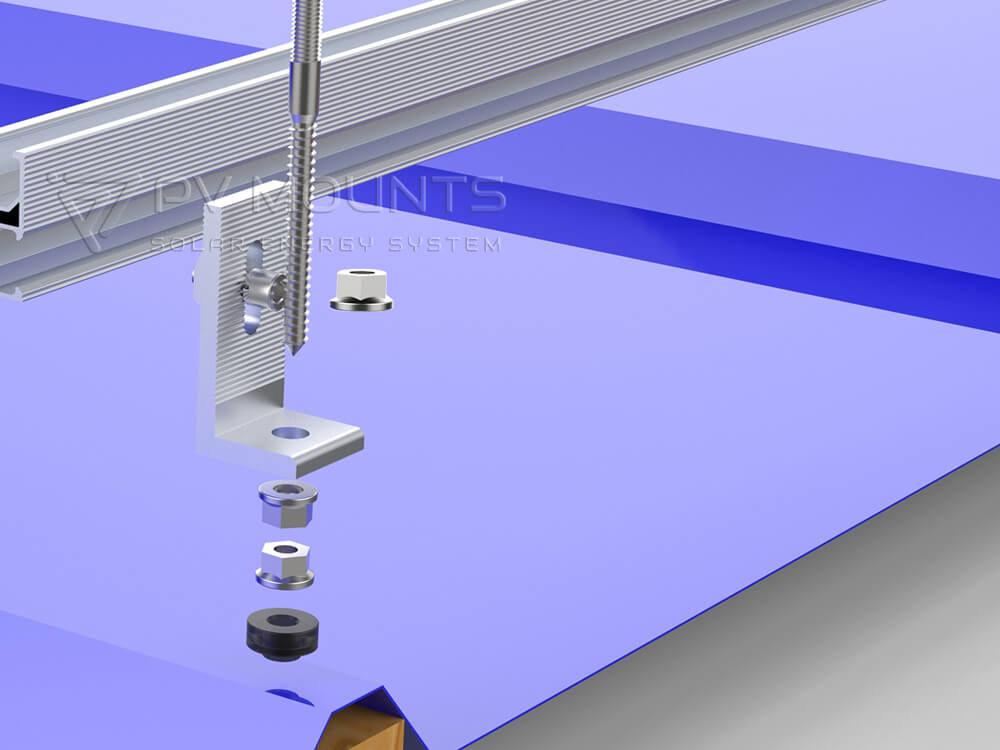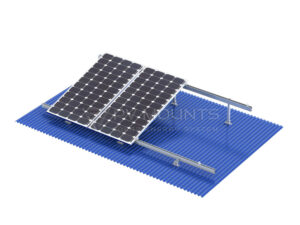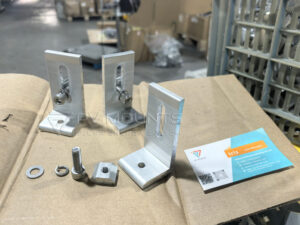Table of Contents
Introduction: The Essential Role of Solar L Feet
When it comes to installing solar panels on corrugated or trapezoidal metal roofs, the L foot—also referred to as L-feet or L-foot brackets—is one of the most critical components. These mounting brackets ensure a secure connection between your roof and the solar rails, providing stability, durability, and long-term reliability.
At PV Mounts, we specialize in manufacturing high-quality aluminum L feet and accessories that cater to installers, EPC contractors, and distributors worldwide. Our L feet solutions are designed to simplify installation while maintaining structural integrity, whether you are working with tin roofs, corrugated sheets, or trapezoidal metal panels.

Understanding Corrugated and Trapezoidal Metal Roofs
Corrugated and trapezoidal sheet metal roofs are widely used in industrial and commercial buildings due to their strength and cost-effectiveness. However, their wavy or ribbed profiles present unique challenges for solar panel installation:
- Corrugated Sheet Metal: Characterized by uniform, wave-like ridges, these roofs require precise L-foot placement to avoid structural damage and ensure secure attachment.
- Trapezoidal Sheet Metal: Featuring rectangular ridges, trapezoidal roofs offer greater surface contact for L-foot mounting, but proper spacing and sealing remain critical to prevent water leakage.
Installing solar panels on these roof types without a proper L foot solution can lead to stability issues, water ingress, or accelerated wear on the roof and PV system.

The Function of L Feet in Solar Mounting Systems
An L-foot bracket serves as the interface between your roof and the solar rails. Typically made from aluminum or stainless steel, the L foot is designed to:
- Support the rail system securely.
- Distribute weight evenly across the roof surface.
- Accommodate different roof profiles, including corrugated, trapezoidal, and tin sheets.
- Allow for attachment using hanger bolts or self-tapping screws depending on the roof type.
PV Mounts L feet are engineered to withstand harsh weather conditions, including heavy wind loads and snow accumulation, ensuring long-term safety and durability for your solar projects.

Types of L Feet for Metal Roofs
Choosing the right L-foot bracket is crucial. PV Mounts offers a variety of solutions tailored to different roofing and mounting requirements:
- Standard L Foot Bracket:
Simple design for small to medium-scale solar installations. Compatible with self-tapping screws for corrugated metal roofs. - L Feet with Hanger Bolts:
Ideal for tin and trapezoidal metal roofs where penetrating bolts are preferred for maximum stability. - Aluminum L Feet Bracket for Tin Roof Solar Mounting:
Lightweight yet strong aluminum brackets with anti-corrosion surface treatment. Suitable for both residential and commercial PV systems. - L Feet with Adjustable Pitch:
Allows installers to customize panel tilt on uneven roofs, enhancing energy output and system flexibility. - Offset Hole L Feet:
Designed for roofs with pre-existing limitations or obstacles, these L feet ensure easy installation without compromising structural integrity.


Installation Guide: L Feet for Corrugated and Trapezoidal Roofs
A professional installation ensures system longevity. The general steps include:
- Preparation:
- Measure roof layout and mark installation points based on panel dimensions and L-foot spacing.
- Roof Penetration:
- For hanger bolt L feet, drill and secure bolts into the roof purlins.
- For self-tapping screw L feet, attach brackets directly onto the metal sheets using waterproof EPDM washers.
- Mount Rails:
- Align rails with installed L feet and secure them using appropriate clamps or fasteners.
- Panel Installation:
- Place PV modules onto the rails, ensuring they are evenly spaced and properly aligned.
- Sealing and Waterproofing:
- Apply silicone or butyl tape around holes to prevent water ingress.

PV Mounts provides detailed installation manuals and accessory kits for each type of L foot, making the process straightforward for installers and EPC contractors.
Materials and Surface Treatment
L feet are exposed to outdoor conditions for decades. Choosing the right material is essential:
- Aluminum L Feet (recommend): Lightweight, corrosion-resistant, and easy to handle; ideal for most metal roof types.
- Stainless Steel L-Foot Brackets: Heavier-duty, suitable for harsh coastal or industrial environments.
- Surface Treatments: Anodized, powder-coated, or hot-dip galvanized finishes protect against UV exposure and corrosion.
Using quality materials not only ensures structural safety but also reduces long-term maintenance costs.
Advantages of Solar L Feet
Installing L feet provides multiple benefits:
- Compatibility: Works with corrugated, trapezoidal, and tin roofs.
- Durability: Strong enough to withstand wind, snow, and weather extremes.
- Ease of Installation: Compatible with hanger bolts or self-tapping screws.
- Cost-Effectiveness: Reduces labor time and prevents roof damage.
- Flexibility: Adjustable pitch and offset designs accommodate various roof layouts.
PV Mounts L feet are designed to meet these demands, ensuring professional-grade quality for your solar projects.

Common Installation Mistakes to Avoid
- Over-Tightening Fasteners: Can deform the metal roof or bracket.
- Mismatched Hardware: Using incorrect bolts or screws may compromise stability.
- Ignoring Waterproofing: Always seal drilled holes with EPDM washers or butyl tape.
- Uneven L-Foot Spacing: Proper spacing is crucial to distribute load and prevent stress points.
Following proper guidelines ensures safety, efficiency, and system longevity.

Choosing the Right L Foot for Your Project
To select the ideal L-foot bracket:
- Identify your roof type: corrugated, trapezoidal, or tin.
- Determine preferred fastening method: hanger bolts or self-tapping screws.
- Verify load capacity according to panel weight and environmental conditions.
- Choose material: aluminum or stainless steel depending on climate exposure.
- Consider accessory requirements: offset holes, adjustable pitch, EPDM pads.
PV Mounts offers expert advice and customized solutions for every scenario, ensuring installers and EPC contractors get the perfect fit.


FAQs About L Feet and Solar Mounting
Q1: Can L feet be used without rails?
A: While possible for small arrays, rails provide stability and allow easier alignment of PV modules.
Q2: Are L feet compatible with standing seam metal roofs?
A: PV Mounts provides specialized L feet for standing seam roofs, minimizing roof penetration.
Q3: How do I ensure waterproofing?
A: Always use EPDM washers, butyl tape, or silicone sealant around all penetrations.
Q4: What’s the difference between hanger bolts and self-tapping screws?
A: Hanger bolts are anchored into roof purlins for high-load stability, while self-tapping screws are ideal for direct attachment to metal sheets.

Conclusion & Call-to-Action
Solar L feet, whether for corrugated, trapezoidal, or tin metal roofs, are essential for a secure, durable, and efficient solar panel installation. Proper selection and installation of L-foot brackets ensure system longevity, safety, and performance.
At PV Mounts, we specialize in high-quality aluminum L feet, L feet with hanger bolts, and self-tapping screw L feet for global solar projects. Our products are trusted by installers, EPC contractors, and distributors worldwide.
Looking for reliable Solar L feet and L-foot brackets for metal roofs? Contact PV Mounts today for durable, professional-grade solar mounting solutions. Get your OEM/ODM quote and ensure your solar projects are installed with the highest quality standards.













